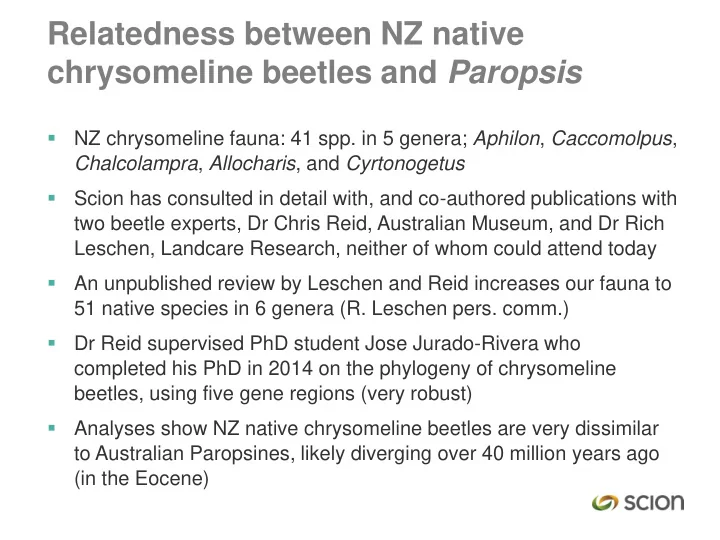

Relatedness between NZ native chrysomeline beetles and Paropsis NZ chrysomeline fauna: 41 spp. in 5 genera; Aphilon , Caccomolpus , Chalcolampra , Allocharis , and Cyrtonogetus Scion has consulted in detail with, and co-authored publications with two beetle experts, Dr Chris Reid, Australian Museum, and Dr Rich Leschen, Landcare Research, neither of whom could attend today An unpublished review by Leschen and Reid increases our fauna to 51 native species in 6 genera (R. Leschen pers. comm.) Dr Reid supervised PhD student Jose Jurado-Rivera who completed his PhD in 2014 on the phylogeny of chrysomeline beetles, using five gene regions (very robust) Analyses show NZ native chrysomeline beetles are very dissimilar to Australian Paropsines, likely diverging over 40 million years ago (in the Eocene)
* Outgroups included Cassida A : 60mya - NZ Aphilon & new genus, and probably A Caccomolpus & and 1 or 2 new Cladistic time-tree genera to be described 2019 of Chrysomelinae C C : 46mya Chrysolina All other genera not shown (those not mentioned in this study) In: Jurado-Rivera, J. A. D: 42mya - 2 branches- NZ (2014). Filogenia Molecular, D Chalcolampra & Allocharis, Sistemática y Evolución de los Cyrtonogetus Chrysomelinae Australianos (Coleoptera, Chrysomelidae ). Ph.D. thesis, University of the Balearic Islands, Spain. K K: 37mya - Dicranosterna L: 35mya - Gonioctena L N: 22mya - All Australian genera incl. Paropsis , Paropsisterna, Trachymela, Paropsides, Peltoschema
Biology of native chrysomelines 5 Genera (Reid 2006) (soon to be 6) in 2 species groups: Aphilon spp. (small, in • Aphilon and Caccomolpus moss) (+2 or 3 new genera) • Chalcolampra, (including Caccomolpus spp., ground dwelling? Allocharis and Cyrtonogetus ) All “naturally uncommon” ? All but one are flightless Few host plants have been Chalcolampra spp. (largest, leaf reported. Beaten from mosses, feeding) ferns, leaf litter, tussocks, etc Larvae mainly feed hidden Allocharis larva
Scion found and tested one species: Allocharis nr. tarsalis Searched sub-alpine Kahurangi Allocharis nr. tarsalis Broun NP with the blessing of Manawhenua ki Mohua and a DOC permit for 18 person days Located this species feeding on Veronica (hebe) albicans Largest known Allocharis (R. Leschen, pers. comm.) External leaf feeding larvae A poor physiological host for Eadya daenerys and not very attractive for oviposition Eadya larva Other species searched for, e.g. could not C. speculifera proved elusive complete development
Is Eadya a threat to native chrysomelines? Native chrysomelines vs Paropsis : Most likely scenario for Eadya attack: Phylogenetically distant (diverged >40mya One or a few Eadya blown into subalpine zone (unlikely to Live in very different habitats intentionally disperse there) (subalpine) Stumble upon native larva (highly Live on very different host plants unlikely to be drawn to either the (shrubs or mosses, none on any host plant or the larva by host Myrtaceae) volatiles) Many likely to be nocturnal feeders Attack native larva (unlikely Eadya not excited by Allocharis without Paropsis larvae to elicit larvae an oviposition response) Eadya unable to complete Unable to develop, population development in Allocharis cannot be sustained
www.scionresearch.com Prosperity from trees Mai i te ngahere oranga Scion is the trading name of the New Zealand Forest Research Institute Limited
Recommend
More recommend